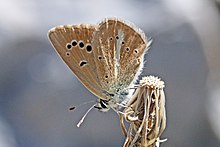You can help expand this article with text translated from the corresponding article in Russian. (April 2023) Click for important translation instructions.
|
| Ripart's anomalous blue | |
|---|---|

| |

| |
| Both in North Macedonia | |
| Scientific classification | |
| Domain: | Eukaryota |
| Kingdom: | Animalia |
| Phylum: | Arthropoda |
| Class: | Insecta |
| Order: | Lepidoptera |
| Family: | Lycaenidae |
| Genus: | Polyommatus |
| Species: | P. ripartii |
| Binomial name | |
| Polyommatus ripartii (Freyer, 1830) | |
| Synonyms | |
| |
Ripart's anomalous blue (Polyommatus ripartii) is a butterfly in the family Lycaenidae.
It is found in Southern Europe, Greece and the Balkans, Asia Minor and the Crimea, South-West Siberia, the Altai Mountains and Kazakhstan. Flies in high summer, July to August in hot dry grassy places and slopes with flowers
It now includes the former Agrodiaetus galloi (Italy), Agrodiaetus exuberans (Italy), and Agrodiaetus agenjoi (Spain), which used to be considered endemic species with highly restricted distribution ranges, but were then shown to be local populations of P. ripartii. It is very similar to Polyommatus admetus and Seitz regards it as a form of admetus - ripartii Frr. (81 f), but has on the hindwing below a white mesial streak which extends from the base to the outer margin.
Its Polish population is considered one of the most endangered butterflies in central Europe.
Etymology
The butterfly is named after the French butterfly collector Rippert de Beaugency (1794–1875).
References
- *Vila R., Lukhtanov V.A., Talavera G., Gil-T F., Pierce N.E., 2010 "How common are dot-like distributions? Taxonomical oversplitting in western European Agrodiaetus (Lepidoptera: Lycaenidae) revealed by chromosomal and molecular markers.Biol. J. Linn. Soc. Lond 101:130-154 (2010)
- Seitz, A. in Seitz, A. ed. Band 1: Abt. 1, Die Großschmetterlinge des palaearktischen Faunengebietes, Die palaearktischen Tagfalter, 1909, 379 Seiten, mit 89 kolorierten Tafeln (3470 Figuren)
 This article incorporates text from this source, which is in the public domain.
This article incorporates text from this source, which is in the public domain.
- Przybyłowicz, Łukasz. “Polyommatus ripartii: the biological basis for the conservation and the morphology of the developmental stages of a critically endangered, relict population in central Europe.” Journal of insect science (Online) vol. 14 247. 1 Jan. 2014, doi:10.1093/jisesa/ieu109
- Luquet, G. C. & Lévêque, A. (2016): Brèves notes biographiques sur le lépidoptériste Jean François Jules de Rippert (°1794 – † 1875) et précisions sur la localisation de ses prospections près de Beaugency. – Alexanor, 27: 197-207.
Gallery
-

-

-
mating
-
 figure from Seitz
figure from Seitz
External links
- Euro Butterflies images
| Taxon identifiers | |
|---|---|
| Polyommatus ripartii | |
| Lycaena ripartii | |
This Lycaenidae-related article is a stub. You can help Misplaced Pages by expanding it. |